What we cover
ToggleFestuca arundinacea
Tall fescue is a cool-season, bunch-type grass that grows with coarse to medium-textured leaves. Adapted to a wide range of soil conditions but performs best in moist, well-drained soils. Good heat and drought tolerance (for cool-season grass) and poor cold tolerance make this species a good choice for transition zone lawns. It will stay green year-round in the transition zone if watered.
It will winter kill when planted in the northern states with temperatures averaging below 10 degrees. A better choice for colder climates is Kentucky bluegrass
Kentucky 31 is the oldest, most common cultivar (cultivated variety). Because of its course texture, this species does not mix well with finer textured lawns and is considered a weed. There are several new and improved “turf-type” tall fescue cultivars that have a finer leaf blade, and darker green color and make a nicer lawn.
Characteristics
- Cool-Season perennial
- Bunch-Type growth habit – spreads by tillering
- Established by seeding
- Dark green leaves
- Coarse textured
- Low to moderate maintenance
- Deep-rooted
- Medium to low water and fertilizer requirements
- Prefers full sunny to light shade
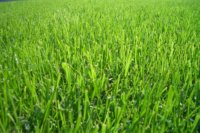
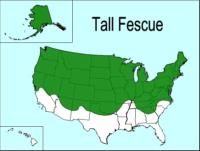
Identification
- Vernation – leaves are rolled in the sheath
- Ligule is Absent
- Auricles are Small
- Leaf blade tips are pointed
- Midrib is present
- Very broad collar
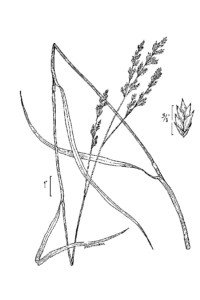
New Lawns
Early fall is the best time to seed or sod cool-season lawns. Spring seeding should be avoided if possible because it does not give the plants time to form a deep root system that they will need to survive the summer. Weed invasion is also a big problem when seeding in the spring. It is better to plant sod if you need to start a new lawn in the spring.
Seed at a rate of 6 to 8 lbs. seed per 1,000 sq. ft.
After planting, keep the seed moist with light and frequent watering for the first 14 to 21 days. Gradually reduce the watering frequency as the grass plants develop. Start mowing when the new grass reaches 2 inches.
Fescue Lawn Maintenance
Mowing
Mowing height is 2 1/2 to 3 1/2 inches. This species does not tolerate close mowing, so cutting higher is best. The turf-type tall fescues can be cut a little lower, they do fine in the 2 to 3-inch range.
Raise the mowing height – 3 to 3 1/2 inches – during the hot summer months.
It is not necessary to remove grass clippings if mowed at the proper height and frequency.
Watering
This grass type has good drought tolerance but needs to be watered in the summer to keep it green.
It requires 1 inch of water every 7 to 10 days.
Proper watering is very important to maintaining a quality lawn. Spring irrigation will decrease the drought tolerance of tall fescue…let Mother Nature do her job. Wait until your lawn shows signs of needing water (wilting, footprint or rolling leaves). Then apply enough water to wet the soil to a depth of 4 to 8 inches. This should be enough to last 7 to 10 days.
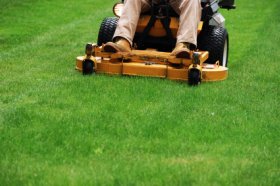
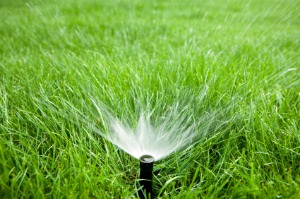
Fertilizing
2 to 3 pounds of nitrogen per 1000 square feet per year is adequate.
The most important time to fertilize is in the fall. Apply 1 to 1 1/2 lbs of nitrogen in September and again in October/November. A light application of 1/2 pound of nitrogen can be applied in early spring. However excess nitrogen fertilizer should be avoided from late spring through August.
Pests, Diseases and Problems
A dense, healthy turf is always the best defense against weed invasion and other pest problems.
Diseases
Brown Patch is the most common disease problem and is related to excessive nitrogen fertilizer and too much water. Avoiding late spring and summer nitrogen fertilization will help prevent brown patches.
Insects
White grubs have been the major insect pest and can be very damaging to tall fescue lawns. Cutworm and sod webworms can also be damaging but are not as common as grubs.
Weeds
It isn’t easy to maintain a nice tall fescue lawn without using a herbicide to control crabgrass. Spring applications of a preemergent herbicide are recommended to keep grassy and broadleaf weeds from invading.
Thinning
Tall fescue tends to thin and become clumpy after a hot and dry summer. It is recommended that you core aerate and overseed every fall to maintain a thick, healthy lawn.
